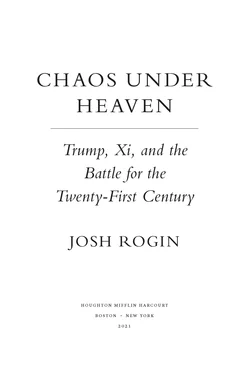The risks for US tech firms working with or in China were apparent for years before the Trump administration came into power, but were largely ignored. Google took a principled stand in 2010 and pulled out of China after their servers were compromised by hackers. But while they hadn’t completely reversed themselves, by 2017 Google was building an AI center of excellence in partnership with Chinese tech giant Tencent in Beijing. Secretly, a team at Google was also working on a censorship-friendly web browser called Dragonfly, but that project was put on ice after employees blew the whistle.
Like academia, the tech sector also had a hard time working with the US government to push back against Chinese depredations. The legacy of the Snowden revelations had poisoned Silicon Valley’s relationship with the national security community in a fundamental way. The firms felt that the National Security Agency had undermined the trust they needed to do business in every other country, and also resented the fact that they had been enlisted to serve national security priorities without their knowledge. Trust needed to be rebuilt, but for many years those conversations simply weren’t happening.
At the end of the Obama administration, a group of Pentagon officials had sought to change that by attempting to reset the relationship with Silicon Valley. Matthew Turpin had been in charge of the plan. He asked the White House to send over one of the tech geniuses that he knew had recently joined the administration on a temporary basis as part of its Presidential Innovation Fellows program, to do a research report on Chinese investment in Silicon Valley. The White House sent over Mike Brown, the former CEO of Symantec. Brown brought in his friends Dan Rosen, an expert on the Chinese economy and founding partner of Rhodium Group, and Pavneet Singh, a trade policy expert and former National Security Council (NSC) official. They set up shop in San Francisco.
They wrote up an internal report on China’s technology strategy, which explained in detail how US tech firms didn’t have to go to China to have their crown jewels stolen; it was already happening here at home. They didn’t release the report, but they didn’t classify it either. Soon it leaked to the New York Times, which first wrote about the Pentagon’s “new White Paper” in March 2017. The full report was made public in January 2018. It stated China was participating in about 16 percent of all new Silicon Valley venture deals, with little to no national security vetting. “China is investing in the critical future technologies that will be foundational for future innovations both for commercial and military applications: artificial intelligence, robotics, autonomous vehicles, augmented and virtual reality, financial technology and gene editing,” it stated. “The U.S. government does not have a holistic view of how fast this technology transfer is occurring, the level of Chinese investment in U.S. technology, or what technologies we should be protecting.”
Brown stayed on to lead the Defense Innovation Unit Experimental, a new Pentagon office meant to help the military keep up with emerging technologies, and Turpin moved over to the NSC. Their work fed into the effort to reform the Committee on Foreign Investment in the United States, but also established a baseline for looking seriously into China’s behavior in our own technology industry. As the tech war heated up more and more over the course of 2018 and 2019, however, every big US firm reacted differently.
Mnuchin Bails Out Google
When the battles among the tech giants of Silicon Valley became entangled in the Washington battles over China, the result was often confusion and chaos. At the National Conservatism Conference in July 2019, Trump-friendly billionaire Peter Thiel launched a public attack on Google, accusing the company of “treasonous” activity for working with the “Chinese military” but refusing to work with the US military (on a project called Maven, which used AI for intelligence sorting). He alleged that Google was thoroughly infiltrated by the PLA, but didn’t provide any specific evidence.
That same month, on July 16, Trump said in a cabinet meeting that his administration would “take a look” at Google’s work in China and suggested that his attorney general might investigate. Eight days later, Steven Mnuchin announced that he had done so instead of the attorney general and that he had discovered that everything was just fine. “The president and I did diligence on this issue, we’re not aware of any areas where Google is working with the Chinese government in any way that raises concerns,” Mnuchin said.
Obviously, there’s no way that Mnuchin could have seriously examined the issue in eight days. Two weeks after that, Trump tweeted that Google CEO Sundar Pichai had visited him in the Oval Office and worked “very hard to explain how much he liked me, what a great job the Administration is doing, that Google was not involved with China’s military.”
Case closed. But in their haste, the Trump team appeared to have missed some crucial details. Although Google wasn’t working directly with the PLA, Chinese military scientists have worked with Google employees on research papers on multiple occasions. And their cooperation with Chinese tech firms on artificial intelligence, according to the testimony of Joint Chiefs chairman General Joseph Dunford, is “a direct benefit to the Chinese military.”
Facebook Flips
The US social media giants had less exposure to the shifting tides of the US-China relationship at first, because Beijing didn’t allow them to operate in the Chinese market and created local domestic copies, such as WeChat, to serve Chinese social media users while still being controllable by the CCP. But over the course of the Trump administration, Chinese internet companies began penetrating the US market and threatening American firms on their own turf for the first time. That forced US tech firms to rethink the nature of the China challenge.
The clearest example of the shift was at Facebook. CEO Mark Zuckerberg made a conscious decision in late 2019 to reorient Facebook’s approach to China 180 degrees. After many years of trying everything he could think of to convince the Chinese government to allow Facebook to operate in China, including asking Xi personally to give his first child a Chinese name (Xi declined), Zuckerberg changed his mind and pledged in an October 2019 trip to Washington that Facebook was no longer seeking access to the Chinese market. Instead, he was now calling on the US government to help US tech firms fight back against China’s tech strategy and pledging that Facebook would fight for American values. “China is building its own Internet focused on very different values, and is now exporting their vision of the Internet to other countries,” he said on October 17 at Georgetown University. “Until recently, the Internet in almost every country outside China has been defined by American platforms with strong free expression values. There’s no guarantee these values will win out.”
The motivations for Zuckerberg’s 180 were clear. He was racing to establish his Libra electronic payment system ahead of a competing system being developed by Alibaba and needed help from Congress and the administration to work out the regulatory structure. Lawmakers were concerned that Zuckerberg’s international electronic payment system would undermine legal oversight of international transactions and weaken the dollar’s role as the dominant world currency. But as Zuckerberg pointed out, if China won the race, Beijing would not afford the US government any of the cooperation and concessions Facebook was prepared to offer.
Facebook was also losing eyeballs by the millions to TikTok, which was owned by the Chinese firm ByteDance, giving Zuckerberg another huge incentive to back US lawmakers’ efforts to rein in China’s ever-increasing technological expansion. TikTok was the first Chinese social media company that caught fire inside the United States. Yet despite its popularity—and despite ByteDance’s protestations to the contrary—reports kept coming out that TikTok’s content managers were censoring anti-CPP messages in users’ videos. There also was evidence that some of the US user data was being routed through China—which, if true, revealed that the company couldn’t be trusted and exposed the personal information of millions of young Americans to Chinese government exploitation.
Читать дальше











